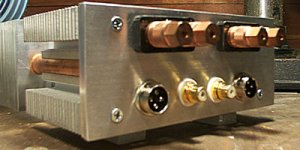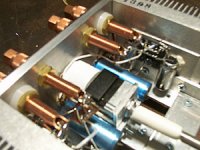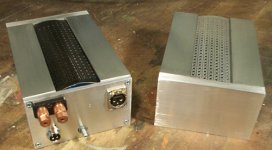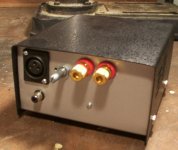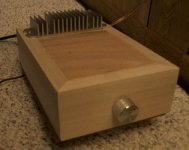Peter,
I've been very impressed with your elegant, austere designs. This is my rendition of your acrylic GC; I took what I felt to be the general feel from this amp, rather attempting a carbon copy. I am still struggling to accomplish in weeks what you can in a few days. 😉
I've been very impressed with your elegant, austere designs. This is my rendition of your acrylic GC; I took what I felt to be the general feel from this amp, rather attempting a carbon copy. I am still struggling to accomplish in weeks what you can in a few days. 😉
Attachments
Here is an ugly little amp that I built as a center channel monoblock. It sits out of sight and gets the job done; I did use good parts for the internals. Most of these amps use Panasonic FC supply caps, Holco (NOS) resistors, and Alps pots. I did some experimenting with Dales. The blue coupling caps are ERO MKP1845...very nice.
Attachments
Coincidence or Bizarro world.
Interesting,
Your first amp has a wooden case.
Peter’s latest amp, also wood. Hmmmm.....
What kind of input transformer did you use in the MB-GC? Is that a motorized pot next to it?
Nice work. Interesting progression.
-Dave
Interesting,
Your first amp has a wooden case.
Peter’s latest amp, also wood. Hmmmm.....
What kind of input transformer did you use in the MB-GC? Is that a motorized pot next to it?
Nice work. Interesting progression.
-Dave
tiroth said:I need a better camera. 😉 The monoblocks are transformer-coupled. There is no input coupling cap, although there is a zobel network on the transformer secondary.
What is that, a power transformer with the dual primaries wired up as primary and secondary windings?
By the way, nice work!
se
Nice work Tiroth. Would you like your efforts included in the Decibel Dungeon Gainclone Gallery?
BTW - I prefer the black vents 😉
BTW - I prefer the black vents 😉
Thanks for the compliments! To answer some questions, yes, I used leftover motorized pots because I have a number on hand.
I did use a Talema power transformer (115:44 nominal) in the monoblocks which is almost exactly 2:1 in the turns ratio. Although this may cause great dismay among some people 😉 this transformer is really quite nice for the application. It is flat from 20Hz-30,000+Hz, although there is some distortion at low frequencies...roughly four times that of a Jensen transformer I believe. By 1kHz though distortion is below -100dB, making it perfect here. (There was some ringing in the 100-150kHz band but that was easy enough to damp)
As a bonus, the monoblocks maintain absolute phase thanks to the transformers.
Nuuk, please feel free to include whatever you want. I think the idea of a gallery is really nice. Thanks!
I did use a Talema power transformer (115:44 nominal) in the monoblocks which is almost exactly 2:1 in the turns ratio. Although this may cause great dismay among some people 😉 this transformer is really quite nice for the application. It is flat from 20Hz-30,000+Hz, although there is some distortion at low frequencies...roughly four times that of a Jensen transformer I believe. By 1kHz though distortion is below -100dB, making it perfect here. (There was some ringing in the 100-150kHz band but that was easy enough to damp)
As a bonus, the monoblocks maintain absolute phase thanks to the transformers.
Nuuk, please feel free to include whatever you want. I think the idea of a gallery is really nice. Thanks!
Nice implementation😉
Have you thought about shielding the amp: top and bottom covers? Originally I wanted to make it open, but the interferences (even signs of oscillating) were so strong, that I had to remove coupling caps (as they picked quite a lot) and install metal mesh on top with a ground attached. Since most of my amp is done from acrylic, I had to also run another wire to ground the pot. I also noticed that best sound is achieved with a single cone in front and acrylic-rubber footing at the back.
Have you thought about shielding the amp: top and bottom covers? Originally I wanted to make it open, but the interferences (even signs of oscillating) were so strong, that I had to remove coupling caps (as they picked quite a lot) and install metal mesh on top with a ground attached. Since most of my amp is done from acrylic, I had to also run another wire to ground the pot. I also noticed that best sound is achieved with a single cone in front and acrylic-rubber footing at the back.
Thanks Peter! I have been considering putting some type of cover on this amp....I have had no problems with oscillation but the noise floor is definitely higher than the fully-enclosed amps. There is a metal subchassis in my amp and the inputs/caps themselves rest partially under the grounded body of the pot, so I think I avoid some noise that way.
Thanks for the suggestion.
Thanks for the suggestion.
- Status
- Not open for further replies.
- Home
- Amplifiers
- Chip Amps
- The Peter Daniel tribute amp

